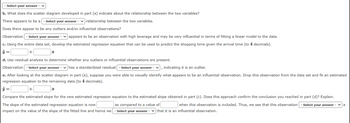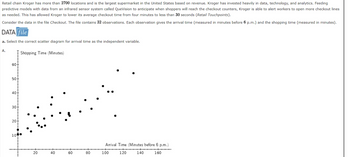
Managerial Economics: A Problem Solving Approach
5th Edition
ISBN: 9781337106665
Author: Luke M. Froeb, Brian T. McCann, Michael R. Ward, Mike Shor
Publisher: Cengage Learning
expand_more
expand_more
format_list_bulleted
Question

Transcribed Image Text:- Select your answer -
b. What does the scatter diagram developed in part (a) indicate about the relationship between the two variables?
There appears to be a - Select your answer -
relationship between the two variables.
Does there appear to be any outliers and/or influential observations?
Observation - Select your answer
appears to be an observation with high leverage and may be very influential in terms of fitting a linear model to the data.
c. Using the entire data set, develop the estimated regression equation that can be used to predict the shopping time given the arrival time (to 4 decimals).
+
x
d. Use residual analysis to determine whether any outliers or influential observations are present.
Observation - Select your answer - has a standardized residual | - Select your answer -
, indicating it is an outlier.
e. After looking at the scatter diagram in part (a), suppose you were able to visually identify what appears to be an influential observation. Drop this observation from the data set and fit an estimated
regression equation to the remaining data (to 4 decimals).
+
x
Compare the estimated slope for the new estimated regression equation to the estimated slope obtained in part (c). Does this approach confirm the conclusion you reached in part (d)? Explain.
The slope of the estimated regression equation is now
as compared to a value of
when this observation is included. Thus, we see that this observation
impact on the value of the slope of the fitted line and hence we - Select your answer that it is an influential observation.
Select your answer
a

Transcribed Image Text:Retail chain Kroger has more than 2700 locations and is the largest supermarket in the United States based on revenue. Kroger has invested heavily in data, technology, and analytics. Feeding
predictive models with data from an infrared sensor system called QueVision to anticipate when shoppers will reach the checkout counters, Kroger is able to alert workers to open more checkout lines
as needed. This has allowed Kroger to lower its average checkout time from four minutes to less than 30 seconds (Retail Touchpoints).
Consider the data in the file Checkout. The file contains 32 observations. Each observation gives the arrival time (measured in minutes before 6 p.m.) and the shopping time (measured in minutes).
DATA file
a. Select the correct scatter diagram for arrival time as the independent variable.
A.
60
50
40
30
20
10
Shopping Time (Minutes)
20
40
60
8-
80
Arrival Time (Minutes before 6 p.m.)
100
120
140
160
Expert Solution
This question has been solved!
Explore an expertly crafted, step-by-step solution for a thorough understanding of key concepts.
This is a popular solution
Trending nowThis is a popular solution!
Step by stepSolved in 2 steps

Knowledge Booster
Similar questions
- Use the following cell phone airport data speeds (Mbps) from a particular network. Find the percentile corresponding to the data speed 0.6 Mbps. 0.4 0.4 0.1 0.6 0.2 0.6 0.7 0.8 1.6 4.8 9.7 1.9 5.4 10.7 0.3 0.6 2.2 5.4 10.9 Percentile of 0.6= (Round to the nearest whole number as needed.) 0.3 0.7 2.5 5.5 11.6 2.6 5.8 12.5 C 2.7 6.2 13.5 0.4 0.9 2.8 6.9 13.8 0.5 1.2 2.8 8.6 14.1 0.5 1.5 A 3.7 8.8 15.5 0.5 1.5 3.9 9.6 28.3arrow_forwardTesla Many analysts cite Tesla as the most innovative car company to enter the automobile industry in recent history. The company was founded in 2003 with the vision of being an independent automaker that would build affordable electric cars. Over the next 17 years, it produced five different car models and continues to introduce concepts for additional vehicles. It has also expanded into home battery and solar panel products. In the first half of 2020, 81% of electric vehicles sold were Teslas, and its affordable sedan, the Model 3, is the all-time bestselling electric vehicle ever. Tesla’s cars helped create a new market for electric vehicles. In addition, its cars have technological components that have advanced safety throughout the automobile industry. Its cars can come with self-driving capabilities and advanced safety warnings. Parts of these technologies have been adopted by other car makers. 1.Think about the automobile industry. Explain what type of market it is by answering…arrow_forwardIf a team from Trilogox came up with the following PFMEA exercise results during its risk exposure analysis: Risk Occurrence Probably will occur Outcome Detection Financial Cost increase by Detection method has 30% medium effectiveness Marketing Probably will not Cost increase by Detection method has medium effectiveness Cost increase by Detection method has medium effectiveness Cost increase by Detection method has 2% occur Quality Probably will occur 40% Capability Probably will occur 10% medium effectiveness Materials Probably will occur Cost increase by Detection method has medium effectiveness Cost increase by Detection method has 10% Labor Probably will occur 40% medium effectiveness b. Which are the most critical risks by identifying the critical values? What actions do you recommend? Evaluate the risks by assigning one degree of leniency in their value.arrow_forward
- What are the three specific desirable characteristics of an estimator?arrow_forwardMacmillan Learning Consider the CEO of a company that sells coffee at small free standing shops around the country. The Board of Directors is considering increasing the number of locations in an effort to increase total revenue, ceteris paribus. Use the data to determine if revenue is responsive to the number of locations. Use the midpoint method to calculate percentages. Number of locations Total revenue Calculate the percentage change in locations. 2012 3000 $60 million Calculate the percentage change in total revenue. Based on the CEO's analysis, he reports to the Board that total revenue is inelastic with respect to the number of locations. total revenue is unit elastic with respect to the number of locations. total revenue is elastic with respect to the number of locations. 2013 3750 $75 million percentage change in total revenue: percentage change in locations: % %arrow_forwardPLS HELP ASAP ON BOTHarrow_forward
- Demand for your firm's products is related to the state of the economy. If the economy is expanding next year, the company estimates sales to be $120 million. If there is a recession next year, sales are assessed to be $40 million. Otherwise, sales are estimated at $70 million. Economists have estimated the chances that the economy will be either expanding, in a recession, or normal next year to be 20%, 30%, and 50% respectively. Calculate the expected annual sales. Enter your numerical answer: expected annual sales: $ millionarrow_forwardDon't use Aiarrow_forwardKindly provide a correct answer and a detailed explanation; otherwise, I will have to give multiple downvotes. Please avoid using ChatGPT and refrain from providing handwritten solutions; otherwise, I will definitely give a downvote. Also, be mindful of plagiarism. Answer completely and accurate answer. Rest assured, you will receive an upvote if the answer is accurate.arrow_forward
- The Janie Gioffre Drapery Company makes three types of draperies at two different locations. At location I, it can make 10 pairs of deluxe drapes, 20 pairs of better drapes, and 13 pairs of standard drapes per day. At location II, it can make 20 pairs of deluxe, 50 pairs of better, and 6 pairs of standard per day. The company has orders for 1000 pairs of deluxe drapes, 2100 pairs of better drapes, and 600 pairs of standard drapes. If the daily costs are $700 per day at location I and $900 per day at location II, how many days should Janie schedule at each location to fill the orders at minimum cost? location I days location II days Find the minimum cost.$arrow_forwardYour insurance firm processes claims through its newer, larger high-tech facility and its older, smaller low-tech facility. Each month, the high-tech facility handles 10,000 claims, incurs $100,000 in fixed costs and $100,000 in variable costs. Each month, the low-tech facility handles 2,000 claims, incurs $16,000 in fixed costs and $24,000 in variable costs. If you anticipate a decrease in the number of claims, where will you lay off workers?arrow_forwardCOVID-19 has caused several shortages: paper products, hand sanitizer, and even nurses. When a hospital needs nurses, they might call Fastaff, which has been sending its nurses all around the country. Once a nurse gets an assignment, they pack their bags and need to be there within a week. During a pandemic, these assignments come with some risk, but these nurses are well compensated for their time. “They really run into the fire,” explained Fastaff Senior VP of Marketing Lauren Pasquale-Bartlett. “They’re very brave, they’re like the special forces of nursing. They go in for these really critical assignments.” The need for traveling nurses across the country has increased drastically because of the coronavirus pandemic. One of the state’s needing nurses is Ohio, according to Pasquale-Bartlett. “Particularly in the last few weeks we’ve seen a two to three increase in demand in requests for nurses to come in and support the staff,” she said. “That really indicates to us that it’s an…arrow_forward
arrow_back_ios
SEE MORE QUESTIONS
arrow_forward_ios
Recommended textbooks for you
 Managerial Economics: A Problem Solving ApproachEconomicsISBN:9781337106665Author:Luke M. Froeb, Brian T. McCann, Michael R. Ward, Mike ShorPublisher:Cengage Learning
Managerial Economics: A Problem Solving ApproachEconomicsISBN:9781337106665Author:Luke M. Froeb, Brian T. McCann, Michael R. Ward, Mike ShorPublisher:Cengage Learning

Managerial Economics: A Problem Solving Approach
Economics
ISBN:9781337106665
Author:Luke M. Froeb, Brian T. McCann, Michael R. Ward, Mike Shor
Publisher:Cengage Learning